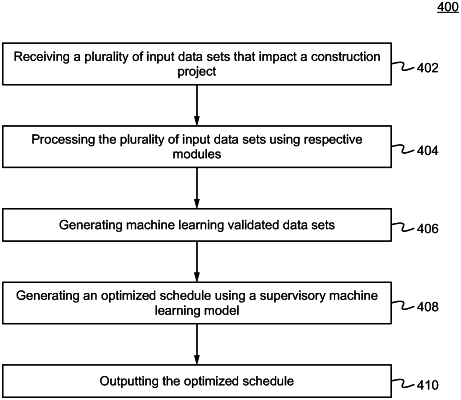| CPC G06Q 10/06312 (2013.01) [G06F 18/217 (2023.01); G06N 20/20 (2019.01); G06Q 10/0633 (2013.01); G06Q 10/103 (2013.01)] | 20 Claims |

|
1. A computer-implemented method, comprising:
receiving, by a server device, a schedule request for a construction activity of a construction project from a client device, the schedule request identifying at least one construction objective;
accessing, by the server device, a plurality of input data sets from a data feed database comprising a plurality of data feeds from various sources based on the at least one construction objective identified from the schedule request;
applying, by the server device, a plurality of ensembles of neural network machine learning models to each of the plurality of input data sets to generate a plurality of intermediary data sets that each identifies factors that impact the construction project, wherein each of the plurality of ensembles of the neural network machine learning models is trained using data related to one or more construction projects according to function objectives of a respective ensemble of the neural network machine learning models;
applying, by the server device, an ensemble of closed-loop efficiency analysis learning models to the plurality of intermediary data sets to determine a schedule for the construction activity, the schedule achieving the at least one construction objective within tolerance levels associated with a baseline schedule, wherein the ensemble of closed-loop efficiency analysis learning models includes:
a stochastic model determining at least one correlation of the plurality of intermediary data sets; and
at least one knowledge and semantic graph model determining task data from the at least one correlation of the plurality of intermediary data sets, wherein the schedule is based on the task data;
causing to render, by the server device, in an interactive graphical user interface, the schedule based on the at least one construction objective identified from the schedule request;
receiving, by the server device, feedback data related to the construction project, wherein the feedback data includes information feeds generated by sensors including one or more of an Internet of Things (IoT) device sensor, a motion sensor, an altimeter, a pressure sensor, a temperature sensor, and a camera;
recalibrating the ensemble of closed-loop efficiency analysis learning models using new training data, wherein the recalibrating includes modifying the stochastic model based on the received feedback data; and
generating, by the server device and from the schedule, an updated schedule for the construction activity using the modified stochastic model.
|